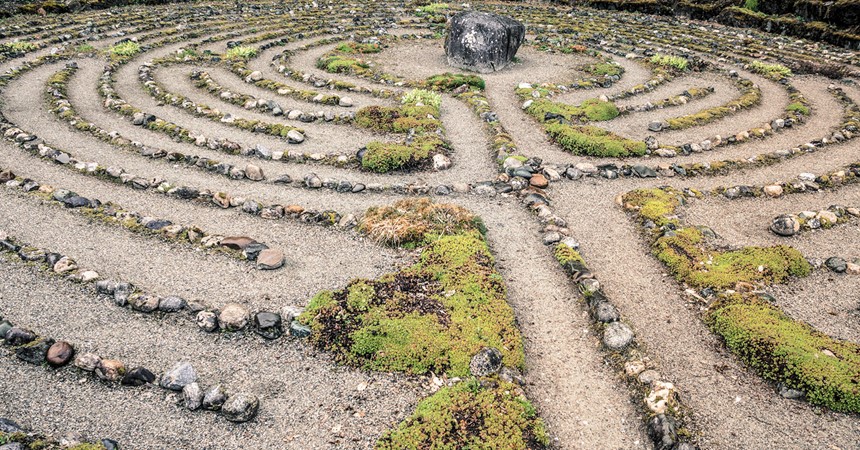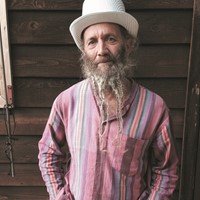A labyrinth is not a maze or a puzzle, it is a path or pattern with a purpose. There is one way in and the path leads to the centre. You can leave the path at any point but you will usually gain some insight by completing the journey − inwards and outwards.
For some, it is plainly the journey from birth to death with a beginning, a series of twists and turns which take you all over, sometimes in what seems to be the wrong direction. Eventually you arrive at the final destination.
I encountered my first walk with a group of friends one June long weekend when we designed a labyrinth on a six metre square cloth.
It was a fun experience. I walked and talked with God as I twisted and turned from start to finish. It became meditative as I slowed down, following the path with both sides of my brain engaged. As I walked towards the centre I gained some insights, which surprised me. One walker was heard to say, “Well, that should take me ten minutes.” An hour later she was still in the middle.
Profound? Definitely. Since then I have become an enthusiast. I make temporary labyrinths on beaches with a stick and more lasting ones on holidays with seaweed or pumice to mark the lines. It might take me six hours to create and every day there is some ‘maintenance’. I enjoy starting the day with a sunrise walk, and any time is good. I love watching others as they encounter the labyrinth.
I make finger labyrinths from timber and find the creating therapeutic. I often quote the Irish saying, “If you want to know the Creator − create.” I have been making them for many years and have had orders from schools and community groups.
My wife Bronwyn and I have run workshops with specific themes, often in churches and parks. We have a temporary labyrinth on our property and there are plans to make permanent ones.
My favourite design is from Chartres Cathedral in France, a classic 11 circuit path. It was inlaid in 1201 and you can usually access it on a Friday when they move the pews. Labyrinths have been part of our human history for thousands of years. How were they used? One can only surmise. That they have been found in different parts of the world with differing cultural and religious backgrounds – Scandinavia, the Mediterranean, India, the Americas − suggests there is something universal in their appeal.
I work as a counsellor and use labyrinths in my work. If a client wants some clarity I will often give him or her time with a labyrinth; “Even a muddy puddle of a mind will clear if given time to settle.” That has certainly been my experience.
I have used labyrinths when troubles and problems plague me. I do walk them just for the fun of helping me get ‘in the zone’ and create some quiet within.
Once I was finishing my day at a community centre when a man arrived, desperate for help. He said he was homeless, depressed and had been suicidal. I told him I needed 15 minutes to complete the day’s task and would be with him after that. I suggested he walk the labyrinth while he waited. I gave him the basics of what was required and left him.
He returned sometime later and I asked, “How was that for you?”
“It was amazing.” Surprised, I enquired further.
He said as he entered the walk and came to one of the turns next to the centre he thought, “This is stupid. All I have to do is step over the line into the middle and have done with it.” Then he said, “That’s what I always do, take the easy road. I have to do the hard yards.”
I asked what the hard yards might mean. “I need to detox and go to rehab. I need to get myself sorted.”
This depressed, suicidal man had worked out his own path without any help from me other than to provide a walking path that helped him settle and be stilled.
Another time a woman said, “Well that was a waste of time, all I got was a sense of peace.” I apologised that she thought she had wasted her time. It’s probably true to say that no two walks are the same and that it can be unhelpful if you have expectations. Enter a walk with open hands, letting go of what is troubling you.
There is no right or wrong way to walk a labyrinth. It is a tool, a path with a purpose, to help you. It is not magical, yet some pretty amazing things can happen.
Kids will often skip, jump, play and enjoy.
Some people have been too scared to try, once I suggest that they may go into their own heart as they walk towards ‘home’, yet I have never witnessed anyone having a negative experience.
Walking with a group of people is a great canvas for working with metaphor and symbols. What do you do when the person in front is too slow? Can you overtake? Go outside the lines? How do you pass someone coming the other way? Why am I agitated with my inability to stay focused? There are a hundred questions − meditations − to be had.
Fosterton Retreat has self-contained accommodation with two cabins and a five-bedroom house. It provides nature and nurture. For guided retreats/workshops you can leave an expression of interest at Fosterton Retreat. If you are aware of a local labyrinth that can be walked, please contact the editor.
Walking the labyrinth
- Clear your mind and become aware of your breathing and feelings. As thoughts drift in, make a note, then let go of them and receive whatever is revealed.
- Enter with a problem/persistent issue and carry it along the path. Ask for wisdom and guidance rather than a yes/no.
- Repeat a phrase over and over to yourself as you journey, eg “the Lord is my shepherd”, “I belong to God”, “I am loved”, “Send your light”…
- Pray your way continuously.
- Carry someone (friend/foe) along the journey and be surprised at what emerges.
- Enjoy the adventure of making time to be quiet and listen.























































































